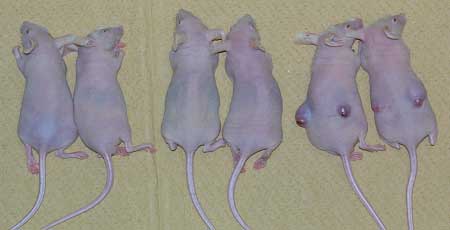| RIKEN Center for Developmental Biology (CDB) 2-2-3 Minatojima minamimachi, Chuo-ku, Kobe 650-0047, Japan |
Now, in a report published in Cancer Research, Kenichiro Kobayashi and colleagues in the Laboratory for Stem Cell Biology (Shin-Ichi Nishikawa; Group Director) identify a second factor, ARID3B, involved in the development of malignant neuroblastoma.Their work, conducted in collaboration with the Kobe University Graduate School of Medicine, indicates that this gene may play a critical role in determining whether or not these tumors follow the path to malignancy, making it a potentially attractive target for cancer therapeutics.
They began by looking at five human neuroblastoma cell lines, which can be grown indefinitely in culture, and measuring the expression levels of MYCN, ARID3A and ARID3B using RT-PCR, a method of amplifying mRNA transcripts. All of the cell lines expressed MYCN, as expected, as well as ARID3B, which stood in contrast to cells of other cancer types, where ARID3B was detected in only two of eight lines. Next they used microarray data from clinical samples obtained from neuroblastoma patients and found that nearly half (9 of 21) of the cells expressed ARID3B, and, importantly, 80% were from stage IV neuroblastomas, aggressive tumors which have typically spread to distant sites in the body and are difficult to treat. Statistically speaking, the case for possible linkage between ARID3B and malignancy was worth pursuing. To test the gene’s function, the group conducted gene knockdowns by short interfering RNA and antisense technology to block ARID3B in neuroblastoma cell lines, and found that in four of the five lines, this resulted in the suppression of cell proliferation, suggesting the potential of this molecule as a therapeutic target. The transformative potential of the gene was then demonstrated in experiments using mouse embryonic fibroblasts (MEFs). Normally, these cells gradually lose their proliferative ability, but those transfected with ARID3B became immortalized, a characteristic of some stem and cancer cell lines in which the cells acquire the ability to survive and grow indefinitely in culture. When co-expressed with MYCN, ARID3B conferred tumorigenicity and anchorage-independent growth, two hallmarks of cancer malignancy, on the MEFs. The physiological role of ARID3B during embryogenesis is thought to involve protecting cells of the neural crest lineage from apoptosis, a function that appears to be hijacked in neuroblastoma tumors. “We first discovered ARID3B from its role in abnormal crest development, but online data from cancer samples has now enabled us to link this basic research to a clinically relevant finding,” notes Nishikawa. “We have been also able to take advantage of published data sets to identify a possibly related role in some other types of cancers, such as pancreatic cancer, which provides a nice demonstration of what can be achieved relatively simply by harnessing information mining technology with the huge amount of data now available to researchers in the life sciences.”
|
|||||||||
|
|||||||||
 |
|||||||||
| Copyright (C) CENTER FOR DEVELOPMENTAL BIOLOGY All rights reserved. |
